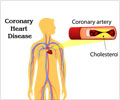Scientists have successfully grown large numbers of stem cells taken from adult pigs’ healthy heart tissue and used the cells to repair some of the tissue damage caused by heart attack.
Johns Hopkins scientists have successfully grown large numbers of stem cells taken from adult pigs’ healthy heart tissue and used the cells to repair some of the tissue damage done to those organs by lab-induced heart attacks. Pigs’ hearts closely resemble those in humans, making them a useful model in such research.
Following up on previous studies, Hopkins cardiologists used a thin tube to extract samples of heart tissue no bigger than a grain of rice within hours of the animals’ heart attacks, then grew large numbers of cardiac stem cells in the lab from tissue obtained through biopsy, and within a month implanted the cells into the pigs’ hearts. With help from a blue-dye tracking system, the scientists have shown that within two months the cells had developed into mature heart cells and vessel-forming endothelial cells.“This is a relatively simple method of stem cell extraction that can be used in any community-based clinic, and if further studies show the same kind of organ repair that we see in pigs, it could be performed on an outpatient basis,” says Eduardo Marbán, M.D., Ph.D., senior study author and professor and chief of cardiology at The Johns Hopkins University School of Medicine and its Heart Institute. “Starting with just a small amount of tissue, we demonstrated that it was possible, very soon after a heart attack, to use the healthy parts of the heart to regenerate some of the damaged parts.”
Marbán cautions that no overall improvements in heart function have yet been shown in these studies, which were not designed to establish such changes and used relatively low numbers of infused cells (10 million or less). “But we have proof of principle, and we are planning to use larger numbers of cells implanted in different sites of the heart to test whether we can restore function as well,” he says. “If the answer is yes, we could see the first phase of studies in people in late 2007.”
The latest Hopkins findings are scheduled to be presented Nov. 13 at the American Heart Association’s annual Scientific Sessions in Chicago. They are believed to be the first results in animal studies to show that so-called cardiac stem cell therapy can be successfully applied with minimally invasive methods to circumstances closely resembling those in humans. Scientists say the results build on earlier studies with cardiac stem cells in mice and humans that demonstrated success in regenerating infarcted heart muscle and restoring heart cell function post-infarct.
For the study, cardiac stem cells were extracted by tissue biopsy from eight pigs whose main arterial blood supply was tightened for more than two hours, duplicating the effects and damage caused by heart attack.
Using techniques developed in Marbán’s lab, researchers extracted about a million cardiac stem cells from undamaged heart tissue, growing them without the use of potentially dangerous chemical stimulators.
Advertisement
Within a month after the initial heart attack, a catheter tube was inserted into an artery in the pig leg for infusing the cardiospheres. Previous research had shown that they would on their own migrate to the damaged zones of the heart. Marbán’s team was able to confirm this because they had labeled the stem cells with a gene that codes for an enzyme producing a blue dye, which could be seen under a microscope.
Advertisement
Closer examination of results revealed that stem cells had matured and grown in the border zones of the damaged area, where researchers suspect both dead and living tissue mingle and some blood supply remains.
“The goal is to repair heart muscle weakened not only by heart attack but by heart failure, perhaps averting the need for heart transplants,” says Peter Johnston, M.D., study author and a Reynolds Foundation postdoctoral cardiology research fellow at Hopkins’ Heart Institute. “By using a patient’s own adult stem cells rather than a donor’s, there would be no risk of triggering an immune response that could cause rejection.”
Source-Newswise
SRM











